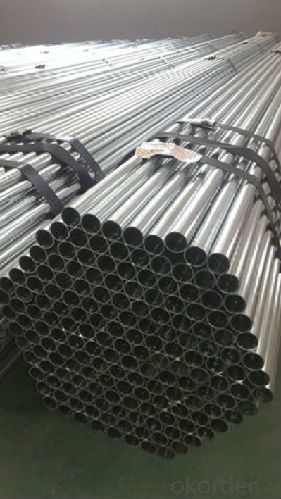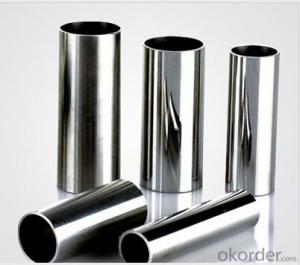Boiler Heat Exchange Stainless Steel Pipe 2205 ASTM A213
- Loading Port:
- Ningbo
- Payment Terms:
- TT or LC
- Min Order Qty:
- 25 m.t.
- Supply Capability:
- 7000 m.t./month
OKorder Service Pledge
OKorder Financial Service
You Might Also Like
1、Structure of Boiler Heat Exchange Stainless Steel Pipe 2205 ASTM A213:
Boiler Heat Exchange Stainless Steel Pipe 2205 ASTM A213 is formed by drawing a solid billet over a piercing rod to create the hollow shell. As the manufacturing process does not include any welding, Boiler Heat Exchange Stainless Steel Pipe 2205 ASTM A213 are perceived to be stronger and more reliable. Historically Boiler Heat Exchange Stainless Steel Pipe 2205 ASTM A213 was regarded as withstanding pressure better than other types, and was often more easily available than welded pipe.
2、Main Features of Boiler Heat Exchange Stainless Steel Pipe 2205 ASTM A213:
• High manufacturing accuracy
• High strength
• Small inertia resistance
• Strong heat dissipation ability
• Good visual effect
• Reasonable price
3、Boiler Heat Exchange Stainless Steel Pipe 2205 ASTM A213 Specification:
Standard | GB, DIN, ASTM ASTM A106-2006, ASTM A53-2007 |
Grade | 10#-45#, 16Mn 10#, 20#, 45#, 16Mn |
Thickness | 8 - 33 mm |
Section Shape | Round |
Outer Diameter | 133 - 219 mm |
Place of Origin | Shandong, China (Mainland) |
Secondary Or Not | Non-secondary |
Application | Hydraulic Pipe |
Technique | Cold Drawn |
Certification | API |
Surface Treatment | factory state or painted black |
Special Pipe | API Pipe |
Alloy Or Not | Non-alloy |
Length | 5-12M |
Outer Diameter | 21.3-610mm |
Grade | 20#, 45#, Q345, API J55, API K55, API L80, API N80, API P110, A53B |
Standard | ASME, ASTM |
1) Material:20#(ASTM A 106/A53 GRB.API5LGRB,GB),45#,16Mn,10#.
2) Specification range:OD:21.3-610mm,WT:6-70mm,length:6-12m or according to the requirement of clients.
3) Excutive standards:GB,ASME API5L.ASTM A 106/A53,Despite of the above standards,we can also supply seamless steel pipe with standard of DIN,JIS,and so on,and also develop new products according to the requirements of our clients!
4) Surface:black lacquered,varnish coating or galvanized.
5) Ends:Beveled or square cut,plastic capped,painted.
6) Packing:bundles wrapped with strong steel strip,seaworthy packing.
4、Packaging & Delivery
Packaging Details: | seaworthy package,bundles wrapped with strong steel strip |
Delivery Detail: | 15-30days after received 30%TT |
5、FAQ of Boiler Heat Exchange Stainless Steel Pipe 2205 ASTM A213:
①How is the quality of your products?
Our products are manufactured strictly according to national and internaional standard, and we take a test
on every pipe before delivered out. If you want see our quality certifications and all kinds of testing report, please just ask us for it.
Guaranteed: If products’ quality don’t accord to discription as we give or the promise before you place order, we promise 100% refund.
②How about price?
Yes, we are factory and be able to give you lowest price below market one, and we have a policy that “ for saving time and absolutely honest business attitude, we quote as lowest as possible for any customer, and discount can be given according to quantity”,if you like bargain and factory price is not low enough as you think, just don’t waste your time.Please trust the quotation we would give you, it is professional one.
③Why should you chose us?
Chose happens because of quality, then price, We can give you both.Additionally, we can also offer professional products inquiry, products knowledge train(for agents), smooth goods delivery, exellent customer solution proposals.Our service formula: good quality+good price+good service=customer’s trust
SGS test is available, customer inspection before shipping is welcome, third party inspection is no problem.
6、Seamless Pipe ASTM A106/53 Images:


- Q: How do you prevent erosion in stainless steel pipes?
- There are several measures that can be taken to prevent erosion in stainless steel pipes. Firstly, it is important to select the appropriate material. Opting for a high-quality grade of stainless steel, such as 316 or duplex stainless steel, which has good resistance to erosion, can greatly reduce the risk. Coating the internal surface of the pipes with a corrosion-resistant material is another effective preventive measure. For example, epoxy coatings are commonly used for this purpose. Managing the flow rate and velocity of the fluid passing through the pipes is crucial. High flow rates and excessive turbulence can accelerate erosion. To regulate fluid velocity and minimize erosion, flow control devices like flow restrictors or flow baffles can be implemented. Regular maintenance and inspection are essential. Routine inspections help identify any signs of erosion or corrosion, allowing for timely repairs or replacements. Additionally, regular cleaning and flushing of the pipes can remove sediment or debris that contribute to erosion. Proper installation and support of the pipes also play a role in preventing erosion. Ensuring that the pipes are properly aligned and supported reduces stress and minimizes the risk of erosion caused by vibrations or excessive movement. Understanding the properties of the fluid being transported is important. If the fluid contains abrasive particles, implementing filtration systems or using strainers can remove these particles before they reach the pipes, reducing erosion. Providing education and training to personnel involved in the operation and maintenance of the pipes is crucial. This includes training on proper handling, maintenance, and troubleshooting techniques to promptly address erosion-related issues. By implementing these preventive measures, erosion in stainless steel pipes can be effectively minimized, ensuring their longevity and optimal performance.
- Q: Are stainless steel pipes suitable for power plant systems?
- Yes, stainless steel pipes are suitable for power plant systems. Stainless steel is known for its excellent corrosion resistance, which is crucial in power plant systems where pipes are exposed to high temperatures, pressure, and various corrosive elements such as water, steam, and chemicals. Stainless steel pipes are highly resistant to rust, oxidation, and scaling, ensuring long-term reliability and durability in power plant operations. Additionally, stainless steel pipes have high strength and are able to withstand the high pressure and stress that power plant systems may experience. They also have excellent heat resistance, which is important in power plants where pipes are exposed to extreme temperatures. Overall, stainless steel pipes are a popular choice in power plant systems due to their corrosion resistance, strength, and heat resistance properties.
- Q: SA-179 what kind of material is steel pipe?
- Compared withsteel and roundsteelinsolid, flexural torsional strength in the same time, the weight is light, is a kind of economic section steel, widely used in the manufacture of structural parts and mechanical parts, such as the oil pipe, automobile transmission shaft, the bicycle frame and steel construction with scaffold with steel pipe manufacturing ring parts can be improved the utilization rate of materials, simplify the manufacturing process, material saving and working hours, has been widely used to manufacture steel tube.
- Q: What are the different surface finishes available for stainless steel pipes?
- Some common surface finishes available for stainless steel pipes include mill finish, brushed finish, mirror finish, satin finish, and bead blasted finish. Each finish has its own unique appearance and texture, catering to different aesthetic preferences and functional requirements.
- Q: How do you prevent pressure loss in stainless steel pipes?
- To prevent pressure loss in stainless steel pipes, there are a few key measures that can be taken: 1. Proper pipe sizing: Ensure that the diameter of the stainless steel pipe is appropriate for the flow rate and pressure requirements of the system. Undersized pipes can result in increased pressure loss due to higher fluid velocities. 2. Minimize pipe length and bends: Keep the length of the stainless steel pipe as short as possible and reduce the number of bends or elbows. Longer pipes and multiple bends introduce friction and turbulence, leading to pressure loss. 3. Smooth interior surface: Use stainless steel pipes with a smooth interior surface finish. This helps to reduce frictional resistance and turbulence, thereby minimizing pressure loss. 4. Avoid unnecessary fittings and valves: Each fitting or valve in a stainless steel pipe system introduces additional pressure loss. Minimize the use of unnecessary fittings and valves, and opt for those with low resistance to maintain pressure. 5. Proper installation: Ensure that the stainless steel pipes are installed correctly, with proper alignment and support. Misaligned or poorly supported pipes can lead to excessive stress and potential deformation, causing pressure loss. 6. Regular maintenance and cleaning: Periodically inspect and clean the stainless steel pipes to remove any accumulated scale, debris, or deposits. Such obstructions can restrict flow and result in pressure loss. 7. Consider flow control devices: Depending on the application, incorporating flow control devices like flow restrictors, pressure regulators, or flow meters can help maintain optimal pressure levels in the stainless steel pipe system. By following these measures, pressure loss in stainless steel pipes can be minimized, ensuring efficient and effective fluid transportation within the system.
- Q: Can stainless steel pipes be used for mining applications?
- Yes, stainless steel pipes can be used for mining applications. Stainless steel is known for its excellent corrosion resistance and durability, making it suitable for the harsh environments and demanding conditions typically found in mining operations. Additionally, stainless steel pipes are capable of withstanding high temperatures, pressures, and abrasion, making them a reliable choice for various mining applications such as transporting fluids, slurry, and chemicals.
- Q: Are stainless steel pipes suitable for mining operations?
- Stainless steel pipes are a suitable choice for mining operations due to their durability and resistance to corrosion. The mining industry often exposes pipes to harsh chemicals, high temperatures, and abrasive materials. These conditions can quickly degrade regular pipes. However, stainless steel pipes are renowned for their exceptional corrosion resistance, enabling them to withstand the challenging mining environment. They also possess high tensile strength, allowing them to endure stress and pressure during the mining process. Additionally, stainless steel pipes are easy to clean. This is crucial in mining operations as it prevents contamination and maintains system efficiency. In conclusion, stainless steel pipes offer a dependable and long-lasting solution for mining operations, making them highly suitable for this industry.
- Q: Can stainless steel pipes be insulated with polystyrene sulfonate?
- Yes, stainless steel pipes can be insulated with polystyrene sulfonate. Polystyrene sulfonate is a commonly used material for insulating pipes due to its thermal insulation properties and resistance to moisture and chemicals. It can be easily applied to stainless steel pipes to provide effective insulation and prevent heat loss or gain.
- Q: Are stainless steel pipes suitable for underground installations?
- Indeed, underground installations can accommodate stainless steel pipes with ease. Renowned for its durability and strength, stainless steel boasts exceptional resistance against corrosion. It effectively endures the harshest underground conditions, enduring moisture, soil movement, and exposure to chemicals. Furthermore, stainless steel pipes remain impervious to rust, eliminating the need for protective coatings and establishing them as optimal for prolonged underground utilization. Moreover, their extensive lifespan and minimal maintenance requirements further solidify their appropriateness for underground installations.
- Q: Can stainless steel pipes be insulated with cellulose?
- Yes, stainless steel pipes can be insulated with cellulose. Cellulose insulation is a versatile material that can be used to insulate various types of pipes, including stainless steel ones. It provides excellent thermal insulation properties and can help prevent heat loss or gain in the pipes, improving their energy efficiency.
Send your message to us
Boiler Heat Exchange Stainless Steel Pipe 2205 ASTM A213
- Loading Port:
- Ningbo
- Payment Terms:
- TT or LC
- Min Order Qty:
- 25 m.t.
- Supply Capability:
- 7000 m.t./month
OKorder Service Pledge
OKorder Financial Service
Similar products
Hot products
Hot Searches
Related keywords




























